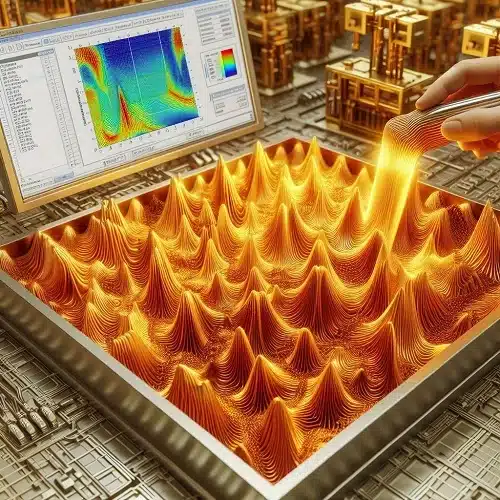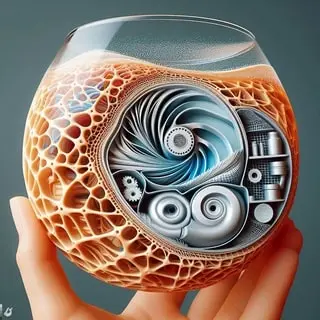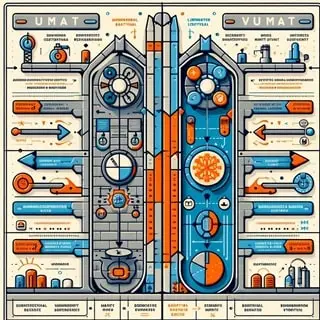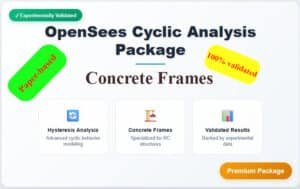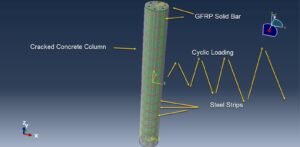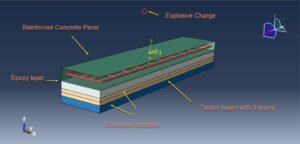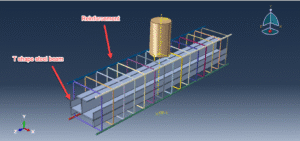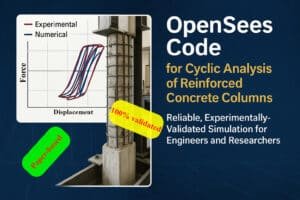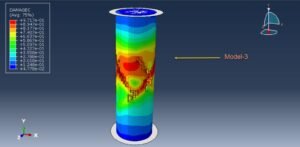Introduction
In the present blog post, we explore the complexities of simulating Additive Manufacturing (AM) through Abaqus, under the guidance of Saman Hosseini. Specifically, our attention centers on incorporating the Goldak heat source model to conduct an in-depth examination of the thermal and mechanical facets of AM processes.

Explaining the Goldak Heat Source Model
The Goldak equivalent heat source (EHS) model is widely utilized as a prominent method to estimate heat input in arc welding processes, notably in gas metal arc welding (GMAW). Welding structure simulations commonly use it based on the finite element method (FEM). Praised for its capacity to distribute heat during the welding process, resembling a molten weld pool; however, the model does have limitations. Despite its praised ability to distribute heat during the welding process, resembling a molten weld pool, the model has limitations. Chiefly, it struggles to accurately depict the temperature field near the weld seam and fusion zone. It exhibits non-physical energy density at the center of the heat distribution, subsequently impacting the accuracy of predictions.

The Goldak heat source model is a pivotal component in simulating AM processes. It involves heat flux parameters that define the heat input during the build process. In the tutorial video, we meticulously select the model’s parameters with values such as b=70× 10−3 mm, a=65× 10−3 mm, 𝑐𝑓=50× 10−3 mm, 𝑐𝑟 =133× 10−3 mm, 𝑓𝑓 =0.6, 𝑓𝑟 =1.4, 𝑓𝑓 + 𝑓𝑟 =2, and 𝑓𝑓 / 𝑓𝑟 = 𝑐𝑓 / 𝑐𝑟. Undoubtedly, these parameters play a crucial role in capturing the heat distribution and forecasting the resulting mechanical properties of the fabricated parts. In this case, we will delve into the analysis of the utilized parameters.
Goldak Parameters
- Parameter “b”: The parameter “b” represents the width of the heat source profile. It determines the size of the heat-affected zone (HAZ) created by the heat source during the additive manufacturing process. (given in millimeters, mm).
- Parameter “a”: Represents the maximum depth of the heat source profile, defining penetration depth into the material (given in millimeters, mm).
- Parameter “𝑐𝑓”: Represents the vertical offset of the heat source from the top surface of the material (given in mm).
- Parameter “𝑐𝑟”: Similar to “𝑐𝑓” but defines the offset from the bottom surface (given in mm).
- Parameter “𝑓𝑓”: Represents the fraction of total heat emitted by the front portion of the heat source during AM (dimensionless, ranging from 0 to 1).
- Parameter “𝑓𝑟”: Represents the fraction of total heat emitted by the rear portion of the heat source, similar to “𝑓𝑓” (dimensionless, ranging from 0 to 1).
- Parameter “𝑓𝑓 + 𝑓𝑟”: Represents the sum of the fractions of heat emitted by the front and rear parts of the heat source.
- Parameter “𝑓𝑓 / 𝑓𝑟”: Represents the ratio of heat emitted by the front part to the rear part.
These parameters play a crucial role in determining heat input and energy distribution during the additive manufacturing process.
The DFLUX Subroutine for Complex Paths
By employing the DFLUX subroutine, we outline the intricate pathways associated with additive manufacturing (AM) processes. The incorporation of 4 tracks per layer, along with a gap of 2 units between tracks, is integral for faithfully simulating the deposition process. In this process, the laser beam follows a predetermined trajectory to effectively melt and fuse the material.

Thermal Model Development
The thermal model development, a crucial step in the simulation process, involves layer geometry with a thickness of 0.03 and substance thickness of 0.5. The meshed model visually represents the part being simulated. The transition from the heat transfer step to the static general step allows consideration of mechanical properties in the model. The simulation imports thermal data from the ODB file and changes the element type from DC3D8 to C3D8, likely due to the need for different mechanical properties.

Mechanical Model Development Algorithm
The algorithm for developing the mechanical model is a step-by-step process, crucial for predicting the part’s behavior under load, involving the addition of mechanical properties to a material. Additionally, the algorithm encompasses changing the step type, importing thermal data, and defining boundary conditions, all of which are essential for creating a realistic simulation of the AM process.

Conclusion
In conclusion, this blog post provides a detailed examination of the AM simulation process in Abaqus using the Goldak heat flux model. Underlining the significance of precise model development, which entails the careful selection of suitable heat flux parameters and the depiction of intricate pathways, as well as the seamless transition from thermal to mechanical modeling. This comprehensive approach plays a critical role in forecasting the performance of additive manufacturing (AM) components and guaranteeing their structural soundness.
In addition, you can visit this link for a complete and precise tutorial on Goldak heat input modeling, and use this instructional video.
Further investigation about Goldak
The Goldak equivalent heat source (EHS) model is widely used for arc welding, especially in gas metal arc welding (GMAW). It accurately distributes the heat of the arc welding process, resembling a melted weld pool. However, the model has limitations in accurately representing the temperature field near the weld seam and fusion zone, exhibiting non-physical energy density at the center of the heat distribution. To address these limitations, Mokorov et al. propose modifications to the Goldak EHS model, replacing the underlying normal distribution equation with an exponential symmetrical distribution for a more evenly distributed heat source. Additionally, a second modification is proposed to distribute the heat at the rear ellipsoid only in the metal of the weld reinforcement and block the heat entry of the lower rear part of EHS in the welded plates. Further study of this research is suggested for a deeper understanding of Goldak and these modifications.

